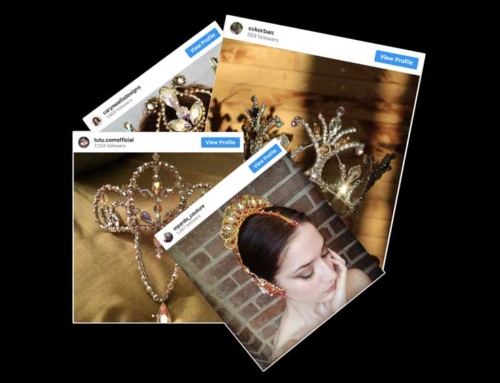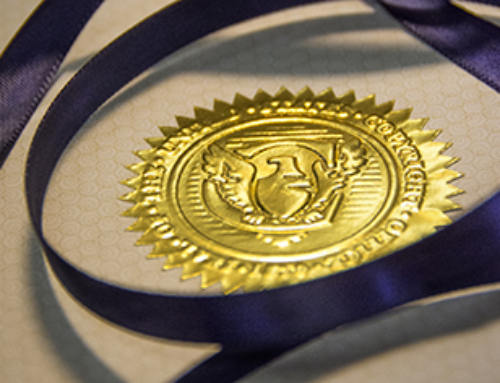Attribution is not always the right thing to do.
A lot of people will say don’t use anything that is copyrighted at all. Don’t even draw inspiration, or if you do provide attribution to the original. Since I am writing this is the context primarily of dance headpieces/jewelry secondly in the context of dance costumes in general, I would like to focus my examples geared to this. The whole of this blog assumes that dance headpieces — tiaras — could be copyrighted as jewelry. Hats are not; and I am afraid some headpiece designs could be considered a hat. Hats, like clothing, are useful articles….so are costumes. And costumes are considered useful articles too (I don’t entirely agree with this blanket statement).
George Balanchine Copyrights Costumes
I’ve heard people say that the George Balanchine Trust has copyrights on its costumes. I have found absolutely no evidence of this. Firstly, they couldn’t copyright the costumes outright as they are useful articles. Only design elements that can stand its own merit as having creative spark can be copyrighted. For example, if you painted a rose, dragonfly, and a bee on a costume; the rose, dragonfly, and bee is copyrightable — not the whole costume. I believe the reason behind this misconception is that the Balanchine Trust will not let you perform one of its works unless they approve of the costumes you are going to use–not that the costumes themselves have some kind-of intellectual property rights.
How many costumes have I seen in Nutcracker productions around the country that have NYCB’s Dewdrop bodice, flowers’ tiered romantic tutu style, or the male candy cane costume? None of these elements are pictorially or graphically unique to obtain a copyright. Although, I could argue that their production is iconic and perhaps could qualify as trade dress. A “costume” could be trademarked or obtain a patent perhaps. I have found uniforms by the UPS, Playboy Bunnies, and cheerleading and mascot costumes trademarked, which are examples of trade dress.
Attribute Who?
Maybe you think I am looking under the wrong tree, and I should be focusing on the designer Barbara Karinska — aka Varvara Jmoudsky. I haven’t found her in a copyright or trademark database either. I didn’t expect to because usually designers and companies draw up contracts. These contracts outline the rights and responsibilities of each party. Anything outside of that contract would be negotiated. However, in the film industry a designer is “work for hire,” and the studio will own the rights to the end product. This also applies to an employee who creates something for their employer–such as text for a brochure. You may be the author, but the company owns your work product.
Thus, if I was a full-time employee for the New York City Ballet, and I made a headpiece for them; they own the “copyrights.” If I stop working there and I wanted to make the headpiece I made while employed there, I will need to get their permission to do so. They would outline what terms that use would require. If I am independent contractor working for New York City Ballet, and they contract me to independently design and craft a headpiece, unless a contractual agreement was made that I would not make these designs for anyone else, I could make and sell as many of those designs as I want. But this doesn’t address who I credit as a person who might be inspired by something.
Who gets credit for designs in theatre settings when much of what is produced is collaborative in nature? A costume designer will hand over drawings to craftsman, who in coordination with the designer, artistic director, and the actors/dancers will come up with an end product. Who then should be credited. And, beyond this if it a work for hire situation and not contract based, the actual company owns the rights. (Movie productions unlike theatre, all contributors are work for hire). Larger organizations might have wardrobe staff; their contributions are owned by their company. However, what if everyone is working on a contract basis; who would you give attribution? Your response might be to provide attribution like this: Inspired by New York City Ballet’s George Balanchine’s The Nutcracker, costume designer Barbara Karinska. I’d say you just broke some intellectual property laws.
Balanchine and NYCB’s names are trademarked and using those names in your product could put you in some legal peril. It could fall under trademark tarnishment, dilution, or just simply infringement. It could be misconstrued that the brand approves of your product or endorses you — unless you explicitly say it doesn’t. Even stating it doesn’t endorse your product doesn’t make this risk go away.
You should ask permission first
The correct answer is, before using a company’s or individual’s name in your product, you should ask permission. I can almost guarantee you that NYCB or any other company out there isn’t going to grant you the right to use their name. Maybe a smaller artist out of ignorance or desire for recognition will, but no big name is going to encourage this–it can be considered brand dilution or can be misconstrued as endorsement. In our NYCB examples above, where it can be reasonably assumed that the tiered design of the romantic tutu, the bodice design in its Dew Drop, or the stripes in the Candy Cane costume are not copyrightable; you have just assumed legal risk by including this famous name in the sale or promotion of your product.
It is a complicated situation, and all of these scenarios contain risk. Without legal advice from a professional, it would near impossible to determine if is a registered copyright (name searching the copyright database is not all too helpful on its own) or adequately creative enough to registered.
Attributing the wrong person
Another potential issue with a person just attributing a source of inspiration, is reverse plagiarism. For example, Let’s say I create a headpiece similar to Pacific Northwest Ballet’s reimagining of George Balanchine’s Jewels. Click the link to view this headpiece on Instagram.
Click here to PNB’s new Emerald’s Headpiece
This is a derivative work of a real tiara–made with diamonds and pearls and worn by royalty. The real designer is unknown, though some say it is Cartier (read about the real jewel’s history here). Does that mean the costume of designer at PNB should receive credit for this design if I do something similar (this is in my inspiration book to do something in cup chain)? I most certainly will not credit PNB, but some know-it-all may claim I copied or was inspired by their version. Poppycock! I would like to be clear: I like PNB’s retake on this classic tiara; I don’t think anyone needed to state its design origin. I find nothing in the wrong here. What I find in the wrong is people who think they can tell you where you got your ideas from; or accuse you of copying; or think drawing inspiration like this is wrong. Sorry-not-sorry. This whole plagiarism bit applied to everything really annoys me.
Appropriating someone else’s authority
Assumed authority is the reason artistic directors and dancers use and request a look or design their productions after other well-known ones — because they know the design premise is accepted. It is considered traditional. Young dancers and even companies are trying to represent classical style–not be unique and original. Performing the choreography of Petipa and wearing costumes that mimic the professional companies allows both companies and dancers performing these roles gain some authority with the way in which they present themselves. By adhering to tradition, one in a sense is a copycat.
Fun fact: The Balanchine Trust has trademarked Balanchine, Balanchine Style, and Balanchine Technique. So the use of those words in any commerce is very, very risky — such as our school teaches Balanchine technique or this piece of choreography is inspired by Balanchine style. So, you see, attribution is not always the wise thing to do.
Y’all, I totally get why the trust did this. They don’t want some random company out there to create a piece of choreography and potentially mislead an audience to think it represents the Balanchine style when in fact it isn’t. They don’t want young people thinking they are learning Balanchine technique when in fact they are not. Would you want a poor representation of what you consider your work tagged “inspired by”? You can easily create a piece of choreography inspired by Balanchine style and perform it without any attribution. Fortunately, NYCB cannot protect style or his technique. You just can’t gain from the use of its name.
One of my biggest personal pet-peeve is the application of schoolwork, academics, and journalism plagiarism standard to copyright law– and, that somehow by attributing work, you have done a good thing. In fact, you now have put yourself in legal peril. Whatever wasn’t copyrightable in the first place, now you may be getting sued for using someone’s name in your product’s promotion.
— Copyright and Fair Use: A Guide for the Harvard Community




